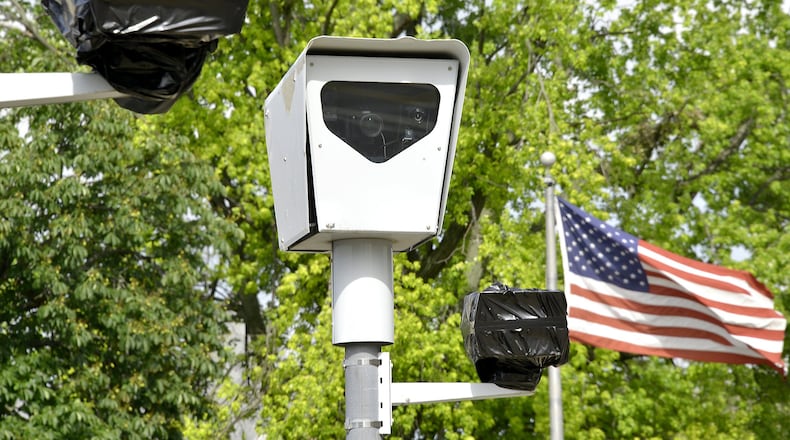Staying with the story
The Springfield News-Sun has been reporting on red light cameras for nearly a decade, including stories digging into crashes at those intersections and the new state law restricting them.
By the numbers
77,000: Red light camera citations issued by the city since the program started
51 percent: Reduction in crashes at intersections with cameras after the devices were installed
$3.4 million: Fines from red light cameras collected since Springfield installed them in 2006
Source: City of Springfield
A Clark County judge upheld Monday the state’s new legal restrictions on traffic cameras that require a police officer’s presence when tickets are issued, rejecting the city of Springfield’s argument that the law is unconstitutional.
The ruling didn’t surprise Mayor Warren Copeland. He noted that other cities, including Dayton, have already vowed to appeal decisions in similar lawsuits.
“It will probably go to the Supreme Court one way or another,” Copeland said.
Springfield suspended its red light camera program in March after the passage of Senate Bill 342, but also filed a lawsuit against the state, claiming the new law violates the city’s home-rule authority.
Common Pleas Judge Douglas Rastatter filed his summary judgment late Monday, saying the law is valid under the home-rule provisions of the Ohio Constitution.
It’s the latest decision in a string of lawsuits by municipalities seeking to keep the revenue generating red-light and speed cameras, which they say improve safety at busy intersections. The cases have revolved around local control versus state authority.
“I’m disappointed in the result,” Springfield Law Director Jerry Strozdas said Monday evening.
The state’s argument has been that uniform law enforcement standards — like speed limits — are within the legislature’s power to regulate.
The language of Springfield’s traffic camera ordinance is “an exercise of police power, not local self-government,” the Ohio Attorney General’s office wrote in a court filing on July 7.
Earlier this year as part of the state budget, a provision was added that would penalize cities for continuing with camera programs by reducing their share of local government funds from the state. The provision requires cities to report fines billed to the state auditor. Those provisions “remove any pretense” and the bill is “nothing but an attempt to kill camera-based traffic enforcement programs,” Strozdas wrote in a July 2 court filing.
The cameras should remain off because the technology often malfunctions, Springfield resident Amanda Meyers said.
“I don’t trust it,” she said.
But Springfield resident John Massie said Springfield should have the right to operate the cameras.
“If you’re not doing anything wrong, there’s nothing to worry to about and you’re not hiding anything,” Massie said.
Springfield leaders have said they won’t turn the city’s cameras back on until the issue is settled statewide in order to avoid driver confusion. Springfield has 17 cameras at 10 intersections.
The Springfield Police Division saw a 47 percent increase in the red light violation detection rates in May. The number of red light detections also rose to more than 5,300 in May, police said, up about 41 percent the same time last year.
Springfield has collected about $3.4 million in fines from red light cameras since they were installed in 2006. It stands to lose about $250,000 this year if the cameras are shelved for good. Springfield has issued about 77,000 citations since the program started.
City leaders insist the program isn’t about money. In 2007, 90 crashes occurred at the intersections with red light cameras. Last year, that number fell to 44 crashes, a 51 percent reduction.
Earlier this month, Ohio’s Second District Court of Appeals rejected the city of Dayton’s claims that it has the right to use the devices.
Dayton is expected to appeal the ruling, but is awaiting a conclusion to similar court cases in Lucas and Summit counties.
Springfield city leaders will have to meet and decide if they want to appeal, Copeland said.
“The state should allow us to make decisions at the local level,” he said. “The Ohio Supreme Court has in the past on this issue felt the same way so we’ll just have to see how it plays out.”
About the Author

